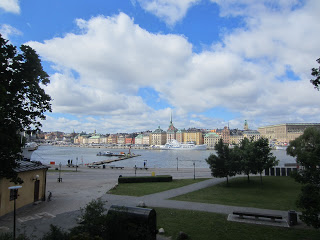Did you know that over one half of the world's population now resides in cities?
Which is your favorite city?
Might it be Boston?
or New York City?
perhaps Miami:
or Buenos Aires:
or Paris:
Stockholm:
Vienna:
or Shanghai?
I took all the above photos during speaking engagement trips over the past several years, except for the Shanghai one, which was taken by a former doctoral student of mine at the World Expo there.
When cities work well those who live in them can flourish in terms of
mobility, health and welfare, accessibility, and innovation.
In the paper, "Design of Sustainable Supply Chains for Sustainable Cities," which is now accepted for publication in the journal, Environment & Planning B, I emphasized that cities, as dynamic complex networks, are the systems and the economic engines for commerce, research and development, education, healthcare, and even culture. They have evolved over space and time on built infrastructure from transportation networks to telecommunication and electric power networks.
At the same time, cities are the centers of resource usage from electricity and other forms of energy and fuel, to food, water, and a plethora of other products. Hence, they also are the repositories and generators of waste output and other environmental pollutants, such as carbon and other emissions, sewage, noise, etc. The term Sustainable Cities has come into increasing use in the past two decades, with a focus of making cities more livable, with an eye not only on the present generation but towards future ones, as well.
Our world is becoming a network of interconnected cities or a supernetwork of cities with urbanization is one of the most pressing and complex challenges of the 21st century, with the citizenry characterized by a growing awareness of a threat to the sustainability of the earth’s natural environment, coupled with the increase in the number of people moving into and living in cities.
Cities are supplied by a complex array of supply chains servicing an immense spectrum of economic activities from food stores and restaurants, office supplies and high tech equipment, apparel, construction materials, as well as raw materials, to name just a few. The sustainability of supply chains is, hence, a precursor to the sustainability of our cities.
According to a Business for Social Responsibility (2009) paper, it is now widely acknowledged that making significant progress on mitigating the impact of climate change depends on reducing the negative environmental impacts of supply chains through their redesign and enhanced management (see also McKinsey Quarterly, 2008). Furthermore, as noted by Capgemini in its 2008 report: 2016: Future Supply Chain, “Preserving energy and raw materials and other resources like water will become a crucial aspect in future supply chains, as costs will likely remain volatile and supplies will continue to dwindle.”
These conditions may well create substantial pressure on current supply chain models.
In this paper, I constructed a new computable mathematical model, that is network-based, for the design of sustainable supply chains with a focus on cities that captures the frequency of network link operations, which is especially relevant to cities due to frequent freight deliveries. An algorithm was then proposed, along with convergence results, and implemented for the computation of several numerical examples.
One of the goals in the paper was to demonstrate how, through the proper design (and operation) of these complex networks, waste can be reduced, along with the environmental impacts, while minimizing operational and frequency costs, and meeting demand.
For a presentation, with the same name, which also includes intellectual foundations inspired by Professor Martin Beckmann, the co-author of the classic book, Studies in the Economics of Transportation, click here.
About Me
- Dr. Anna Nagurney
- Dr. Anna Nagurney is the Eugene M. Isenberg Chair in Integrative Studies at the Isenberg School of Management at the University of Massachusetts Amherst. She was appointed to this chaired professorship on April 14, 2021. Prior to this chaired professorship, since 1998, she was the John F. Smith Memorial Professor of Operations Management. She is the Founding Director of the Virtual Center for Supernetworks, which she established in 2001. Professor Nagurney has held positions at Harvard, MIT, Brown University, Oxford University, the Royal Institute of Technology (KTH), the University of Gothenburg, and the University of Innsbruck. She is the author/co-author of over 235 journal articles and over a dozen books. Nagurney is regularly sought out by major media outlets because of her expertise on supply chains and networks systems plus policies. She has given many keynote and other invited talks internationally.
Subscribe To RENeW


Recent Visitors
Blog Archive
-
▼
2013
(177)
-
▼
March
(14)
- Looking Forward to Speaking at the University of O...
- UMass Tough
- Felt Like the Chairman of General Motors
- The Best Thing About the US is the National Scienc...
- Good-Bye to Sweden, For Now
- Inauguration of a Professor -- The Swedes Do It wi...
- Building Sustainable Cities and The New York Times...
- Sustainable Cities Via Sustainable Supply Chains
- Thank You to the Vienna University of Economics an...
- A Terrific Visiting Professor Program at an Intern...
- The Great INFORMS Student Chapter at UMass Amherst
- Network Economics and the Internet
- Grand Challenges and Opportunities in Supply Chain...
- Great Lufthansa Flights and Great to be Back in Sw...
-
▼
March
(14)



























